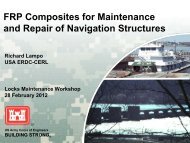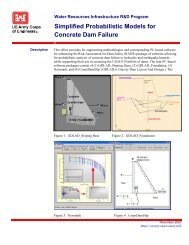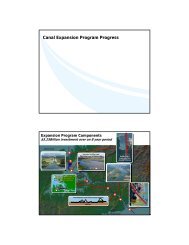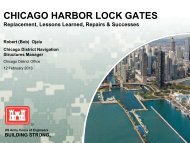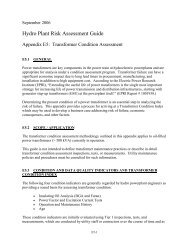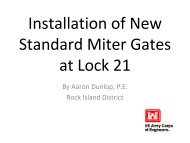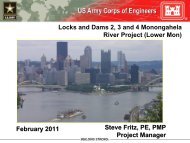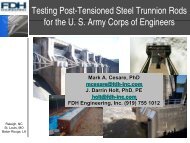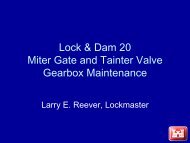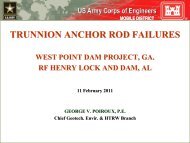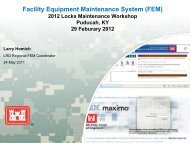Stoney Gate Valves at Lake Washington Ship Canal - U.S. Army
Stoney Gate Valves at Lake Washington Ship Canal - U.S. Army
Stoney Gate Valves at Lake Washington Ship Canal - U.S. Army
You also want an ePaper? Increase the reach of your titles
YUMPU automatically turns print PDFs into web optimized ePapers that Google loves.
<strong>Stoney</strong> <strong>G<strong>at</strong>e</strong> <strong>Valves</strong><br />
Are Their Days Numbered?<br />
-Hiram M. Chittenden Locks<br />
David Chapman<br />
Mechanical Engineer<br />
Se<strong>at</strong>tle District<br />
Draft January 12, 2013<br />
US <strong>Army</strong> Corps of Engineers<br />
BUILDING STRONG ®
Agenda<br />
• Brief project history<br />
• <strong>Stoney</strong> <strong>G<strong>at</strong>e</strong> <strong>Valves</strong> – description<br />
• Current condition of the valves<br />
• Desired future for the valves<br />
• Design st<strong>at</strong>us<br />
• Discussion<br />
BUILDING STRONG ®
Hiram M. Chittenden Locks – Quick Facts<br />
• Connects the fresh w<strong>at</strong>er of Se<strong>at</strong>tle’s <strong>Lake</strong><br />
<strong>Washington</strong>, <strong>Lake</strong> Union, and Salmon Bay to the<br />
salty tidal w<strong>at</strong>ers of Puget Sound.<br />
• Consists of two sets of locks, a spillway, and a fish<br />
ladder.<br />
• Serves the purposes of:<br />
-Maintaining lake w<strong>at</strong>er levels <strong>at</strong> 20-22 ft.<br />
-Allowing for bo<strong>at</strong> traffic to and from Se<strong>at</strong>tle’s<br />
lakes to the Puget Sound.<br />
-Preventing salt w<strong>at</strong>er penetr<strong>at</strong>ion of the fresh<br />
w<strong>at</strong>er bodies of Se<strong>at</strong>tle.<br />
BUILDING STRONG ®
Hiram M. Chittenden Locks – Quick Facts<br />
• Built in 1911<br />
• 1.3 million visitors annually<br />
• 50,000 vessels passed annually<br />
• 1 million tons of commercial goods annually<br />
BUILDING STRONG ®
Hiram M. Chittenden Locks – Quick Facts<br />
Also……<br />
• The Carl S English Jr. Botanical Gardens<br />
• Home to the NWS Commander<br />
BUILDING STRONG ®
Se<strong>at</strong>tle<br />
BUILDING STRONG ®
Hiram M. Chittenden Locks<br />
Small Locks<br />
Spillway<br />
Large Locks<br />
BUILDING STRONG ®
Large Locks<br />
Miter <strong>G<strong>at</strong>e</strong>s<br />
BUILDING STRONG ®
Large Locks<br />
- 2 filling culverts<br />
- 3 sets of <strong>Stoney</strong> <strong>G<strong>at</strong>e</strong> <strong>Valves</strong><br />
BUILDING STRONG ®
Filling Culverts<br />
Dimensions:<br />
8’ 5” x 14’<br />
Flow:<br />
Avg. 1500 CFS<br />
Max: 2034 CFS<br />
(per culvert)<br />
BUILDING STRONG ®
<strong>Stoney</strong> <strong>G<strong>at</strong>e</strong> <strong>Valves</strong><br />
Dimensions:<br />
8’ 5” x 14’<br />
BUILDING STRONG ®
<strong>Stoney</strong> <strong>G<strong>at</strong>e</strong> <strong>Valves</strong><br />
BUILDING STRONG ®
<strong>Stoney</strong> <strong>G<strong>at</strong>e</strong> <strong>Valves</strong><br />
BUILDING STRONG ®
<strong>Stoney</strong> <strong>G<strong>at</strong>e</strong> <strong>Valves</strong><br />
BUILDING STRONG ®
<strong>Stoney</strong> <strong>G<strong>at</strong>e</strong> <strong>Valves</strong><br />
BUILDING STRONG ®
<strong>Stoney</strong> <strong>G<strong>at</strong>e</strong> Valve Equipment<br />
Electric Motor<br />
Drive Shaft to<br />
Square Thread<br />
Power Screws<br />
BUILDING STRONG ®
<strong>Stoney</strong> <strong>G<strong>at</strong>e</strong> Valve Equipment<br />
Drive Shaft to<br />
Square Thread<br />
Power Screws<br />
Lifting Rod<br />
Connected to<br />
Valve Body<br />
W<strong>at</strong>er Seal<br />
BUILDING STRONG ®
<strong>Stoney</strong> <strong>G<strong>at</strong>e</strong> Valve Equipment<br />
Split Bushing<br />
For Crosshead<br />
Controls?<br />
BUILDING STRONG ®
Elev<strong>at</strong>ion View<br />
W<strong>at</strong>er Seal<br />
Valve Body<br />
Crosshead<br />
Rollers<br />
Lifting Rod / Valve Body<br />
Connection<br />
BUILDING STRONG ®
Current Condition<br />
Quick glance shows robust valve bodies to be in decent shape.<br />
BUILDING STRONG ®
Current Condition<br />
Close inspection<br />
reveals fractures,<br />
loose/missing nuts,<br />
and multiple modes<br />
of corrosion.<br />
BUILDING STRONG ®
Current Condition<br />
BUILDING STRONG ®
Current Condition<br />
Castings are<br />
experiencing<br />
multiple modes of<br />
corrosion.<br />
Many bolts are<br />
missing.<br />
BUILDING STRONG ®
Current Condition<br />
Excessive and<br />
uneven wear on<br />
roller pads.<br />
BUILDING STRONG ®
Current Condition - Rollers<br />
A picture is worth<br />
1000 words<br />
BUILDING STRONG ®
Roller Train Problems<br />
• Broken roller discovered during 2012<br />
pumpout and inspection.<br />
BUILDING STRONG ®
Roller Train Problems<br />
• Turns out roller issues are not a new problem.<br />
BUILDING STRONG ®
Wh<strong>at</strong> can be done?<br />
• We do have replacement parts for one set<br />
of g<strong>at</strong>es…but then wh<strong>at</strong>?<br />
• We can salvage parts from the #2 set of<br />
g<strong>at</strong>es…but then wh<strong>at</strong>?<br />
BUILDING STRONG ®
Wh<strong>at</strong> are the ramific<strong>at</strong>ions of this fix?<br />
• <strong>Valves</strong> cannot form a proper seal.<br />
• <strong>Valves</strong> cannot be integr<strong>at</strong>ed into the<br />
control systems safety interlocks as<br />
intended.<br />
BUILDING STRONG ®
Wh<strong>at</strong> should be done?<br />
BUILDING STRONG ®
Plans on the Shelf<br />
• Plan 1<br />
BUILDING STRONG ®
Plans on the Shelf<br />
• Plan 2<br />
BUILDING STRONG ®
Concluding Questions<br />
1. Wh<strong>at</strong> type of hydraulic system should we implement?<br />
2. Does anyone have experience swapping UHMW wear<br />
pads for the rollers?<br />
3. Should the valve body be rehabbed and reused or<br />
should it be redesigned entirely?<br />
4. Wh<strong>at</strong> type of tolerances should we design the valve slot<br />
to have?<br />
5. Wh<strong>at</strong> can be done to deter barnacle growth?<br />
BUILDING STRONG ®




